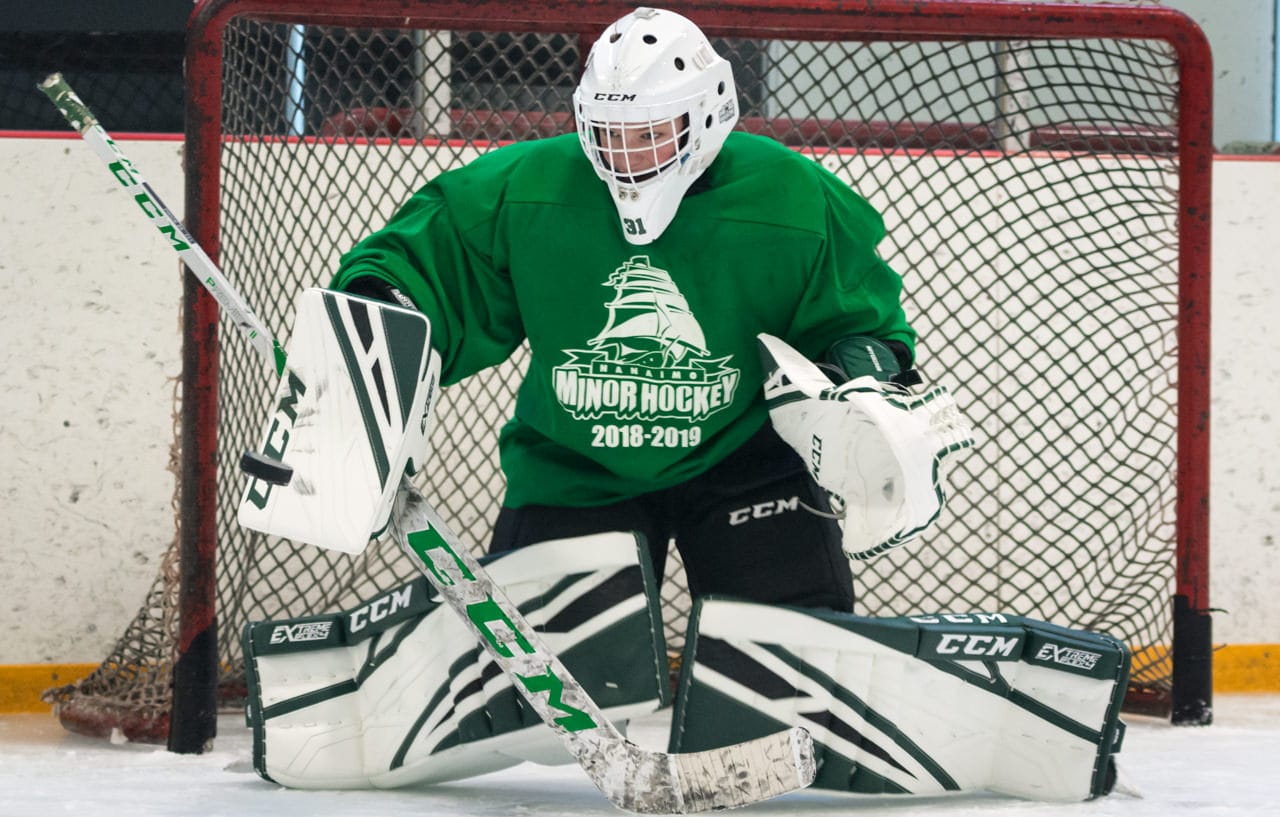The biggest change in the new CCM Extreme Flex 4 glove isn’t easy to spot. You will notice it as soon as you try to close it, however.
CCM re-aligned the pocket angle of their stock 600-break in the E-Flex 4 line, creating a more natural extension of the break in the palm, and making it easier to close the deeper double-T pocket that became the stock option on the Extreme Flex 3 line two years ago. Where the break was more in line with the top T in the previous model, it runs right between the double-T in the E-Flex 4, creating a better open-and-close “snap” in this glove right out of the box.
It’s not a huge difference but it is noticeable, and eliminates the need for goaltenders to choose a single-T when custom ordering a 600-break CCM glove, which had become a bit of a trend because the previous double-T didn’t close as smoothly out of the box as it did on 590 and 580 breaks. Speaking of break options, we’ve got a complete overview below, but first let’s go over the rest of the improvements on the new CCM Extreme Flex 4 glove.
(Click any image to enlarge)
Like the slight shift in the pocket angle, those upgrades are subtle.
CCM made significant changes to the E-Flex 3 glove in consultation with Carey Price, creating a notably deeper pocket and reconfiguring the one-piece cuff by shifting more of the coverage above the wrist to add high coverage without sacrificing seal between the glove and pants, or the top of the pad when goalies are down in more of a butterfly. They also moved to a double-t pocket as the stock retail option in the line, widening the gap to improve visibility, a feature Price also noted in our review of the E-Flex 3 gloves. Those changes were well received at retail and in the NHL, and in the spirit of “if it isn’t broke, don’t fix it,” the E-Flex 4 glove maintains the most popular features of past models, with a few minor tweaks and improvements.
The most obvious change is the addition of a quick-release wrist strap tab on the outside of the glove, which doesn’t change much for goalies that like to leave this strap loose but makes life a lot easier for those that prefer to cinch it up tighter. In past gloves that strap was contained inside the outer wrist cuff, so you had to open that up to tighten it, and the excess strap was loose inside the cuff. By adding the tab outside the cuff, CCM solved both issues.
Like the slight shift in the pocket angle, those upgrades are subtle.
CCM made significant changes to the E-Flex 3 glove in consultation with Carey Price, creating a notably deeper pocket and reconfiguring the one-piece cuff by shifting more of the coverage above the wrist to add high coverage without sacrificing seal between the glove and pants, or the top of the pad when goalies are down in more of a butterfly. They also moved to a double-t pocket as the stock retail option in the line, widening the gap to improve visibility, a feature Price also noted in our review of the E-Flex 3 gloves. Those changes were well received at retail and in the NHL, and in the spirit of “if it isn’t broke, don’t fix it,” the E-Flex 4 glove maintains the most popular features of past models, with a few minor tweaks and improvements.
The most obvious change is the addition of a quick-release wrist strap tab on the outside of the glove, which doesn’t change much for goalies that like to leave this strap loose but makes life a lot easier for those that prefer to cinch it up tighter. In past gloves that strap was contained inside the outer wrist cuff, so you had to open that up to tighten it, and the excess strap was loose inside the cuff. By adding the tab outside the cuff, CCM solved both issues.
The other small change is inside the glove to the Velcro tab that runs over top of the mesh-and-neoprene finger stalls, and it started with the Premier 2 glove we reviewed last spring. This tab allows goaltenders to adjust the tension over their fingers, and therefore the grip pressure under their fingers into the palm. CCM widened this tab significantly (it’s almost three times wider) and split it in line with the double-T, significantly expanding the adjustability compared to the E-Flex 3 glove, which featured a thin Velcro tab that only allowed goalies to adjust the tension straight across the fingers. Now they can angle it up or down too.
Many key features have been carried over from Extreme-Flex 3 and Premier 2 lines, including the use of impact-absorbing D3O foams in the palm of the glove for increased protection and insulation from puck impact (by absorbing the impact, not kicking it away like a harder material might), the use of Speed Skin material on stock gloves, and increased protection over the back of the finger tips for goalies turning their glove over in reverse-VH.
CCM will also continue to offer three levels of protection at custom: a “Game Ready Palm” with 5/16-inch layer of felt; the “Pro Palm” with a 1/2-inch layer of felt; and the “Practice Palm” with two 5/16-inch layers. But since adding the three-millimeter layer of D3O to the palm, they have seen a decrease in the use of “practice” gloves right up to the NHL. And because that thin layer of D3O in the palm won’t break down, goalies will still be protected even as the rest of the glove softens over time, enhancing the durability in a line already known for it.
Speaking of durability, CCM gloves continue to use more-expensive injection molded plastic components rather than compression molded parts that tend to lose their shape faster.
Breaking down the CCM Breaks
The stock option on the CCM Extreme Flex line has always been a 600 break, which debuted not long after Price switched to CCM and helped them develop the new glove. It closed more like a first baseman’s glove, for lack of a better comparison, with the index fingertip closing into the tip of the thumb and the pocket extended out from, rather than above, the hand.
The 600 break continues as the stock option on the E-Flex 4 line, but CCM has allowed goalies to order custom breaks in both the E-Flex and Premier lines for several generations now, and Price himself switched to a 590 break on his glove this season, news that broke when InGoal Magazine was with him for the annual Day with Price event near his offseason home.
“I loved the feel of the 600 but it extends out more, and with my long arms I don’t want to cover outside the net,” Price explained. “The 590 brings my hand back in tighter to my body, and it felt like when you bring everything in, it sits there a little better.”
Price also noted the 590 break, which closes with the tips of the fingers pulling more into the palm of the hand, was better for using a Turco grip when handling the puck, but required some adjustment when holding the glove below the stick to make passes. At the end of the day, it’s all personal preference, with more goalies trending towards the old 580 break as well but a mixture of young and old from both lines also using the 600 break, including veteran Marc-Andre Fleury with his Premier 2 set up, and rookie Carter Hart in his Extreme Flex 4.
With all that in mind, we thought it might be a good time to revisit the different breaks.
CCM 600 Break
Who wears it: Carter Hart, Marc-Andre Fleury, Michael Neuvirth, Pheonix Copley, Martin Jones, Casey DeSmith, David Rittich, Daren Millard
As mentioned above, the 600 break closes more like a first baseman’s glove, with the tip of the index finger pulling into the tip of the thumb. The pocket extends out from the end of the thumb, almost a straight-line extension of the forearm, instead of up above the hand like the other CCM breaks. The pocket and fingers are also noticeably longer than the other models — roughly one full inch longer. It creates more of an oval, or as one CCM rep described it, a football shape to the glove. While it’s become increasingly rare to talk about the angle of the break on a glove, CCM says the 600 break is technically a 50-degree break angle.
CCM 590 Break
Who wears it: Carey Price, Pekka Rinne, Jusse Saros, Brian Elliott, John Gibson, Connor Hellebuyck, Louis Domingue, Philipp Grubauer, Malcolm Subban, Kevin Woodley
The 590 break, which comes stock on the Premier 2 glove but is available in E-Flex 4 as well, is technically a 60-degree break. This break is pretty much a straight line from the bottom of the palm all the way through the tip of the pocket and stays intact when it closes. It closes with the fingers pulling more into the palm than the 600 but not quite as much as the 580, with the index finger lining up at, or just above, the base of the thumb when the glove is closed.
CCM 580 Break
Who wears it: Mike Smith, Sergei Bobrovsky, Roberto Luongo, Curtis McElhinney, Jacob Markstrom, Braden Holtby, Jordan Binnington, Michael Hutchinson, Adin Hill, Matthew Hutchison
The 580 has a more vertical break in the palm, rising closer to the thumb than the 590. While the 580 is commonly labeled a 90-degree break, this is not an accurate description of the angle of the break through the palm of the glove. With the bottom of the cuff serving as an anchor for such measurements, the implication is a 90-degree angle would rise parallel to that line, but that actually describes the pocket of a 580, not the palm. That’s because when a goalie closes their hand in the 580, the top of the pocket actually folds over back towards the thumb, rising straight up and parallel to the base of the cuff. So, when someone describes a 580-break CCM glove as having a 90-degree break, they’re really talking about the pocket. The fingers are also a bit longer, to accommodate for the glove sitting deeper and the break more in the palm.
You can see the difference in the closures by where the finger portion of the glove ends up in relation the thumb once it is squeezed tight, with the steeper 580 actually pulling over the thumb, while the 590 sits inside. The 580 is more of a fingers-to-palm closure, with the fingers pulling in towards the base of the thumb, almost like making a fist, except the fingers don’t curl in and the thumb stays up, like a “thumbs up” gesture. The steeper break sits below the bottom of the knuckles, creating more of a full hand closure. Some goalies like how the pocket extends further up above the hand, or over the shoulder towards the mask with the fingers up.
Continuing with the “if it isn’t broke, don’t fix it” theme, the CCM E-Flex 4 blocker builds on the success that has seen NHL goalies like Ryan Miller still using it despite wearing other catcher and leg pads. While there are some notable changes from the E-Flex 3 blocker, most are a continuation of improvements made in the Premier 2 blocker last spring.
That includes re-designing the inside thumb protection by removing the big pillow that used to sit between the thumb and the side board and replacing it with more high-density foam to maintain the protection while also reducing weight and improving balance. The thinner profile is noticeable visually and on your hand compared to an E-Flex 3, and pro and tester feedback all noted the improved balance when the change was first made on the Premier 2 blocker.
The biggest new feature unique to this year’s Extreme Flex 4 blocker that wasn’t in the Premier line is the addition of a nylon quick-release wrist strap, something Price used in Montreal. It replaces the Velcro strap that used Speed Skin, which remains the stock surface material, and is a nice combination with the more open and adjustable cuff now standard on CCM blockers.
The New CCM E-Flex blocker comes with a nylon quick-release wrist strap.
The other, more subtle change is on the elastic attachment between the index finger and the outer finger protection. Where the E-Flex 3 elastic between the index and middle finger attached atop the finger, the E-Flex 4 is anchored at the inner edge, which keeps that outer protective layer pulled closer. And should a puck still roll up the paddle or deflect in a way that gets past that outer layer, CCM continued the use of a layer of impact-absorbing D3O foam that wraps around the tip of the index finger for increased protection.
The E-Flex 4 blocker is binding-less (you can custom order it with the binding around the edges) and comes stock with their grey Sure Grip material but traditional Nash but is also available on custom orders. The palm comes centered in a stock blocker, but can be custom ordered in an offset high position, and can also be custom ordered in intermediate size for smaller hands or in XL for bigger hands. The extra layer of finger protection between the sidewall and index finger comes stock as the “straight” option, but the “curved” protection can be ordered as well.
If you haven't already, please check out our E-Flex 4 Pad Overview.
Index finger with D30 protection and enhanced elastic attachment to outer finger protection.
Straight finger-protection is stock on the E-Flex blocker.
If you haven't already, please check out our E-Flex 4 Pad Overview.
Comments
We’d love to hear your thoughts – let us know below!



















0 Comments